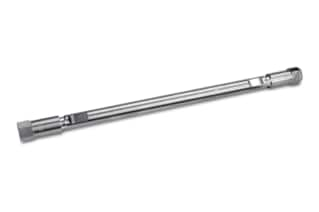
|
Chemistry |
C18 |
|
Separation Mode |
Reversed Phase |
|
Particle Substrate |
Silica |
|
pH Range Min |
2 pH |
|
pH Range Max |
8 pH |
|
Temperature Limits |
45 C |
|
Maximum Pressure |
6000 psi (415 Bar) |
|
Endcapped |
Yes |
|
Bonding Technology |
T3 |
|
Silanol Activity |
Medium |
|
Particle Shape |
Spherical |
|
Particle Size |
3.5 µm |
|
Endfitting Type |
Waters |
|
Pore Size |
100 Å |
|
Format |
Column |
|
Surface Area |
230 |
|
System |
HPLC |
|
Particle Technology |
HSS |
|
USP Classification |
L1 |
|
Inner Diameter |
3 mm |
|
Length |
150 mm |
|
Carbon Load |
11 % |
|
UNSPSC |
41115709 |
|
Brand |
XSelect |
|
Product Type |
Columns |
|
Units per Package |
1 pk |

XSelect HSS T3 Column, 100Å, 3.5 µm, 3 mm X 150 mm, 1/pk
The XSelect HSS T3 Column is built on the HSS (High Strength Silica) Technology which has been developed by Waters to complement the chromatographic performance of BEH (Ethylene Bridged Hybrid) and CSH (Charged Surface Hybrid) particles. The XSelect HSS T3 Column offers supreme reproducibility and transferability. It possesses the chemical and physical characteristics for seamless scalability. These distinct features of the XSelect HSS T3 Column make it the perfect lab equipment as it will provide you with higher resolution separations that are required for complex samples in order to isolate and quantify the sample constituents. It combines efficiency and selectivity to enhance the resolution of very complex samples.
The HSS technology embedded within the XSelect HSS T3 Column gives you distinct advantages over the BEH and CSH technologies. It offers higher silanophilicity, which will provide you with increased polar compound retention and significantly different selectivity in your analysis. Along with this, the High Strength Silica (HSS) technology has been developed to carry the mechanical strength necessary to work with the UPLC pressures.
We recommend that when developing separations for polar and nonpolar compounds, opt for the XSelect HSS T3 XP Column. The column has a low-coverage C18 phase compatible with 100% with aqueous mobile phase. These features of the XSelect HSS T3 Column provide it with ultra-low MS bleed, but also fully scalable and transferable to UPLC separations.
You can increase your productivity with the ideal lab equipment. To learn more about the variations of the same product, such as The XSelect HSS T3 Column, or to find additional products that work with it, check out our shop for lab equipment; you can browse through our website, refer to our catalog and ensure your lab needs are met as needed.
You may also want to look into our Reversed-Phase QC Reference Material; it is a unique collection of standards and mixtures. Specifically designed to provide this complexity and is appropriate when complex assays are routinely performed. It can be used with a variety of column chemistries, dimensions, and system hardware. It contains 7 compounds, including uracil, butylparaben, naphthalene, propranolol, dipropyl-phthalate, acenaphthene, and amitriptyline at pH 7.
Why Is Water Used As A Mobile Phase?
Pure water in elevated temperature can be used as a mobile phase in liquid chromatography mainly due to change of dielectric constant. Water dielectric constant is reduced from 85 at 25°C to 35 at 200°C because water behaves like an organic solvent.